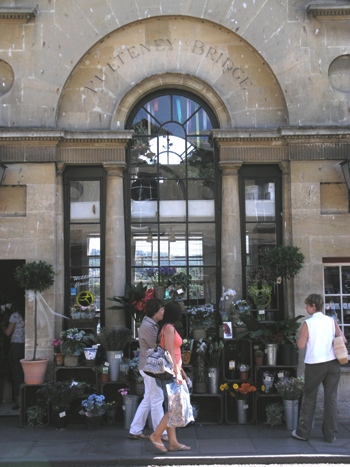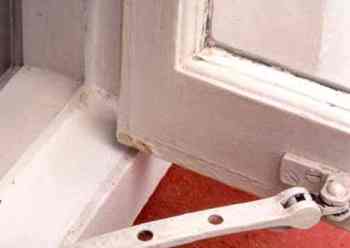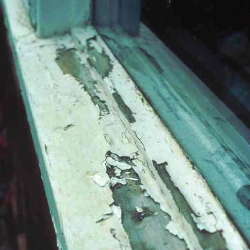The Case for Micro-porosity
Does it hold water?
Peter Kaczmar
 |
|
| Lead paint is arguably the most effective protective coating for timber, but its use has been banned on all but the most historic buildings because it is so toxic. Modern alternatives are often marketed as being 'microporous'. |
At the start of the last century, wood-coating technology enjoyed a period of relative stability when little energy was expended in the development of new or improved coatings. Then, joinery was manufactured from large-sectioned, slow-grown wood and protected with flexible lead-based paints which seldom showed the type of failures that have become so characteristic of their modern day equivalents.
One could be forgiven for saying that, based on the frequency of observed failures, today's coating technology has shown a seemingly retrograde development. The reason for this apparent incongruity has often been blamed on shifts in attitudes in silviculture, which saw timber make the transition from being an abundant building commodity to that of a scarce and valuable resource. The consequence was that the definition of acceptable timber quality was redefined to maximise the use of a shrinking resource. This in turn placed seemingly unrealistic demands on existing coatings which were expected to perform well despite the fact that the nature of the substrate beneath them had changed. This is reflected in our historic buildings, where the original woodwork is manufactured from large-sectioned, slow grown temperate hardwoods that do not exert the same demands on paint coatings as today's more rapidly produced counterparts.
In reality, this is an oversimplification, since it does not take into account legislative pressures exerted against the use of lead paints which began as early as 1921, when the International Labour Organisation (ILO), in recognition of its toxicity, implemented a convention restricting the use of white lead in paints. This eventually culminated in the UK Paint Regulations of 1927 (now superseded by the Control of Lead at Work Regulations 1998). Today, the UK regulations allow the manufacture and use of white lead paint only in controlled and special circumstances for the decoration of Grade I and II listed historic buildings (England and Wales) and categories A, B and C(S) (Scotland). Strict regulations apply to its use and the general sale of lead paint in the UK is prohibited.
Against this backdrop, the wood coatings industry was forced to adapt and manufacturers responded by developing new types of coatings, including the development of systems where the lead component (lead carbonate) was substituted with titanium dioxide. One of the main advantages of lead carbonate is that it reacts with linseed oil to produce fatty-acid soaps which are both tough and elastic, with good wetting properties. This is arguably the principal reason why white lead was used so commonly for the protection of wood substrates: it could produce a resilient, relatively impermeable protective film capable of responding to movements of the wood caused by changes in air humidity and substrate moisture content. It was the inherent ability of the old lead-based paints to accommodate movements within the substrate which was the key to their success when used to protect exterior wood. Formulation technology has responded to restrictions in their use through the development of alternatives, among them the acrylic and vinyl-based systems and polyester products which led to the development of the traditional 'alkyd systems'.
 |
||
| Paint cracking around the joints is a common problem in modern paint systems due to the relative brittleness as they age. The eventual result is flaking and peeling (illustrated below right). |
In many ways history is repeating itself: in just the same way as health and safety controls signalled a radical change in the direction of developments during the 20th century, imposition of environmental legislation has set in motion further changes at the start of the 21st. These are apparent in the proliferation of low volatile organic compound (VOC) - or 'compliant' - coatings, including waterborne dispersions, hybrid products and high-solids coatings. The upsurge in the availability of alternatives has provided today's consumer with a wide choice of products, and established a highly competitive market. Manufacturers have been forced to develop alternative coating strategies backed up by claims which have, over the years, had a runaway effect on the way coatings are perceived in the context of joinery protection. Nowhere has this been more noticeable than in the case of 'micro-porous' or 'breathable' paints and paint systems, where justifiable technical claims have, over the years, been heavily exaggerated to increase marketing impact.
The concept of 'micro-porosity' stemmed from the need to control and reduce the build-up of moisture within wood joinery to below 21 per cent - generally accepted as the point at which timber starts to become susceptible to attack from wood-destroying organisms.
Before the advent of micro-porous coatings, alkyd paints were widely used as the main protection strategy for window joinery. Alkyd resins are polyesters which have been chemically reacted with a drying oil. This process results in the formation of a three-dimensional interconnecting network of molecular 'chains' which resist the passage of water and form a hard film. It has the benefit of being easy to clean with solvents and is less prone to sticking or blocking when freshly painted. However, its main drawback is that it tends to embrittle with age, becoming progressively less responsive to dimensional movements within the woodwork. When this occurs, cracking of the paint film around joints is the usual result, with the consequence that rainwater can be drawn into the wood at the point of fracture by capillary attraction.
Once inside, the water has no effective means of being vented out since it cannot re-emerge past the alkyd paint. The result is that moisture build-up within the fabric of the joinery occurs to a point at which it can both trigger the development of rot and also interfere with the surface adhesion of the intact coating, causing its eventual delamination. The result is peeling and flaking paint, a scenario which is all too familiar in the context of restoration work.
 |
Coatings manufacturers were quick to realise that one of the most effective ways of controlling moisture in joinery was through the formulation of paints which were more permeable and which could allow any entrapped moisture within the joinery a ready means of escape.
Permeability is defined as the amount of water which can pass through a given area over a given period of time and is usually expressed in terms of grams per square metre per day (g/m²/day). Coating permeability is defined as the transmission of moisture across a film, usually in vapour form. It can be determined either on the basis of the thickness of the applied coating (film permeability) or in terms of the permeability when applied at a specific thickness, usually 100µm (specific permeability).
There are pitfalls in the use of the practical guidance offered by permeability data insofar as the measurements may differ according to whether they have been calculated on the basis of water loss or moisture absorption. In practice, permeability may be influenced by the density and interaction of the substrate, as well as being significantly influenced by variances in temperature, humidity, the moisture gradient present within the joinery and the age of the coating. As with many things, there is a balance to be struck. If coating permeability is too high, it may lead to splitting and deformation of timber components. If it is too low, it may not allow moisture to escape readily and may lead to decay. The real problem from the user's standpoint is that no agreement currently exists on what the optimum figure for any given end use should be. Consequently, providing data on permeability becomes largely academic, since there is little of practical value to guide the consumer.
Over the years there has been a tendency to use permeability as a marketing tool, referring to it in terms such as 'open', 'ventilating', 'breathing' and 'micro-porous' to promote sales. This has led to the erroneous perception that micro-porous paints somehow constitute a specific category or generic class of coating. In reality it can be argued that most paints are 'micro-porous' to a certain extent, being capable of allowing at least some moisture to pass through the cured coating.
It is also a common misconception that 'micro-porous' paints can let water escape from painted wood without allowing it to enter. In essence, if a coating is permeable it will allow moisture in vapour form to cross it in both directions, as dictated by the relative vapour pressure differential which exists on both sides of the paint film. Herein lies a paradox for the consumer. Does he select a coating which can vent excess moisture from within a window frame if climatic conditions are dry, in the knowledge that the same coating might equally be responsible for a rise in the moisture content of the window if conditions are wet? Much has been written and said about the issue of micro-porosity and the illusion still persists that it is in some way a 'cure' for many of the problems which are a common feature of painted woodwork. In reality, it is used by specifiers as a palliative.
Yet there are much more important issues to consider. Many of the arguments in favour of using micro-porous paints can be dismissed by careful detailing and good design, which can go a long way to excluding water uptake in the first place. The irony here is that conservation work by its nature deals with the restoration of original building features irrespective of whether they work to the benefit of long-term function or not. One can make a case for using a permeable paint system as a measure to offset or delay the inevitable consequences of bad design. However, one can make an equally valid argument for using less permeable paint systems if, because of their greater properties of extensibility, they can effectively prevent moisture penetration and resist the onset of premature cracking - white lead paint gives that option.
Modern coating technology is able to offer the conservationist a range of alternative systems which are neither very permeable nor toxic to health. However, it is important to select coatings based on a logical treatment of the specific issues in a given project and to resist marketing pressures to choose a coating which may not be right for the job in hand.
~~~
Recommended Reading
- J Graystone, The Care and Protection of Wood, ICI Paints Division, Slough, 1985
- EA Hilditch and RJ Woodbridge, 'Progress in Timber Finishing in Great Britain', Journal of the Oil and Colour Chemists' Association, London, 1985
- TRADA Wood Information Sheet 2/3-1, Finishes for Exterior Timber, 2005



